August 30, 2020
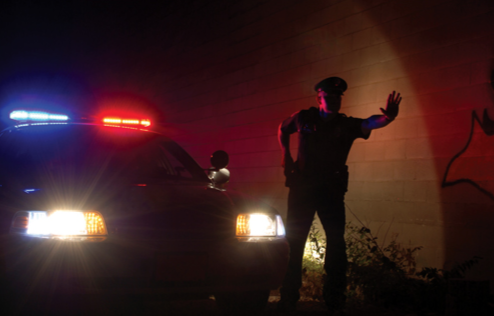
written by Net Advisor™
Excerpt: This report seeks to provide a general understanding with regard to law-enforcement use of force and rules that govern force. A random sample of officer-involved shootings are discussed.
Some of videos in this report contain actual live-recorded graphic shooting content, and are not recommended for any under 18. Sensitive viewers may also find the videos disturbing. Alternatively, one can read this report’s text without watching the videos and have the same understanding of events that transpired. A note appears before each video in [brackets] describing what type of activity took place in the respective video.
Report also includes a guide to help avoid getting into a potential officer-involved shooting situation; and what to do if have a weapon in a vehicle during a traffic stop.
WASHINGTON, DC. The National Institute of Justice has said, “There is no single, universally agreed-upon definition of use of force.” Use of force rules can vary by city, county, or state. However, one will find that rules of force may not be radically different from one city to another.
For example, one is not going to see an officer shoot someone who parked in a fire-lane – unless of course the subject pulls a gun on the officer.
In 2019, there were 89 law-enforcement officers killed in the line of duty. Of this total, 48 officers killed in “felonious act” (officers attacked), and 41 killed in accidents.
[1] General Use of Force Rules.
Use of force generally can take place when there is imminent threat to life or property. This includes any threat to citizens and law-enforcement.
There are a number of factors that can affect actions and outcomes in use of force situations.
Police officers are held to a higher standard when it comes to use of force. Their job also requires officers to enter into potentially high risk situations all day, every day. This does not mean they have the right to exercise just any use of force, but only when situations may warrant such.
The National Institute of Justice guideline is as follows:
“Law enforcement officers should use only the amount of force necessary to mitigate an incident, make an arrest, or protect themselves or others from harm.”
— Source: National Institute of Justice, Mar. 5, 2020
Officers may carry a variety of weapons including a Taser, knives, chemical defenses, clubs, batons, and firearms. An officer does not have to match the weapon of their subject. If a subject is holding say a knife at an officer, the officer is not required to pull their knife to make it an ‘even’ fight.
When a subject presents themselves as a threat with a weapon that could be lethal to the officer, or a threat to other persons; and the subject is holding the weapon in a threatening manner, or verbally stating threats of using the weapon against the officer(s), or other persons; the officer can ‘ratchet up’ (escalate) the use of force to defend their, or another person’s life.
At the same time, if a subject becomes complaint, and the imminent risk of life or property has been mitigated, the officer should decrease (or de-escalate) the use of force as appropriate.
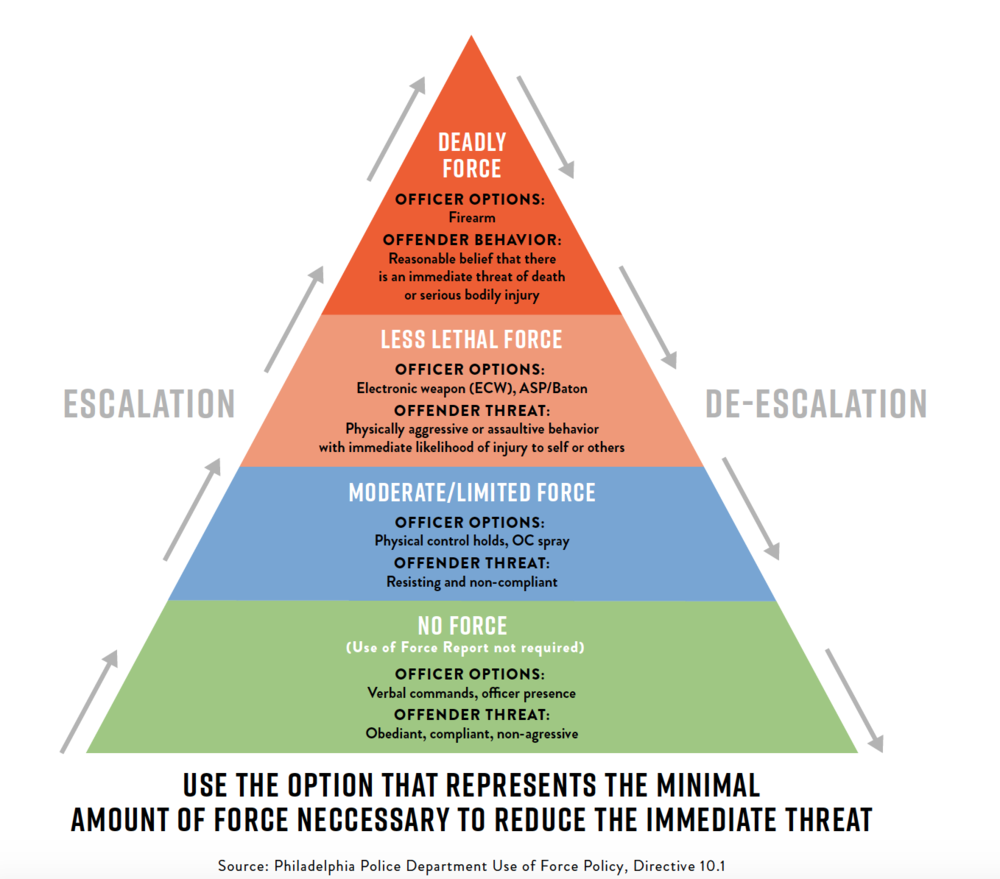
The National Institute of Justice posted its last guidelines for The Use-of-Force Continuum on August 3, 2009.
Here are some examples where various use of force could be used.
[2] Subject with ‘No Weapon.’
A subject with no weapon is always a misnomer. Many in the media like to equate that an “unarmed” subject is never a threat, thus there is no reason to ever shoot an unarmed subject?
Every physically capable person has the ability to fight, and use their body as a weapon. A subject could attempt to take a weapon from an officer; or use any object as a weapon during a fight.
If a subject has capable arms and legs, they can flee to a location where they know they can get a weapon to use against an officer or innocent civilian. What kind of use of force that may be used in these instances largely depends on all the events that led up to and during the incident.
According to the FBI in 2019 alone, four law-enforcement officers were intentionally killed when the subject had no weapon in hand, but subject used their vehicle as a weapon to kill officers.
Another issue is when law-enforcement officers have contact with subjects who may be under the influence of controlled substances. Depending on the substance, this can temporarily give the subject the ability to fight better, ignore or resist pain.
Narcotics can also decrease one’s ability to use sound judgement, become highly emotional, flair to anger or violence rapidly, escalating a use of force situation.
The long-term or even periodical use of especially harder controlled substances, including but not limited to: cocaine, methamphetamine, PCP, heroin, opioids, and Fentanyl) damage the body’s organs and could lead to unintended death.
- The 50 Most Dangerous Drugs (2016) (Most are OTC or prescription)
- Drugs that will rot your flesh, destroy your vital organs, and turn you into a zombie.
[3] Subject with a Knife or Similar.
Just because the subject may have a knife in possession, does not mean the officer can just go ahead and shoot the subject. The subject would need to exhibit behaviors in a threatening and non-complaint manner. This can include but is not limited to, subject threatening to use weapon (along with verbal threats); wielding weapon in a threatening manner; or subject closing distance (willfully moves toward the officer) with weapon in hand, where such increases the threat of harm to the officer.
[4] Subject with Non-Firearm, Stun-gun or Taser.
If the subject has any type of a projectile weapon or otherwise a weapon that could incapacitate the officer, the officer may not have to wait for the subject to move closer toward the officer before the offer responds. For example, a projectile weapon (ie: Taser) automatically closes the distance to the officer, placing the officer in harm’s way. In this instance, the officer is more than likely to use lethal force.
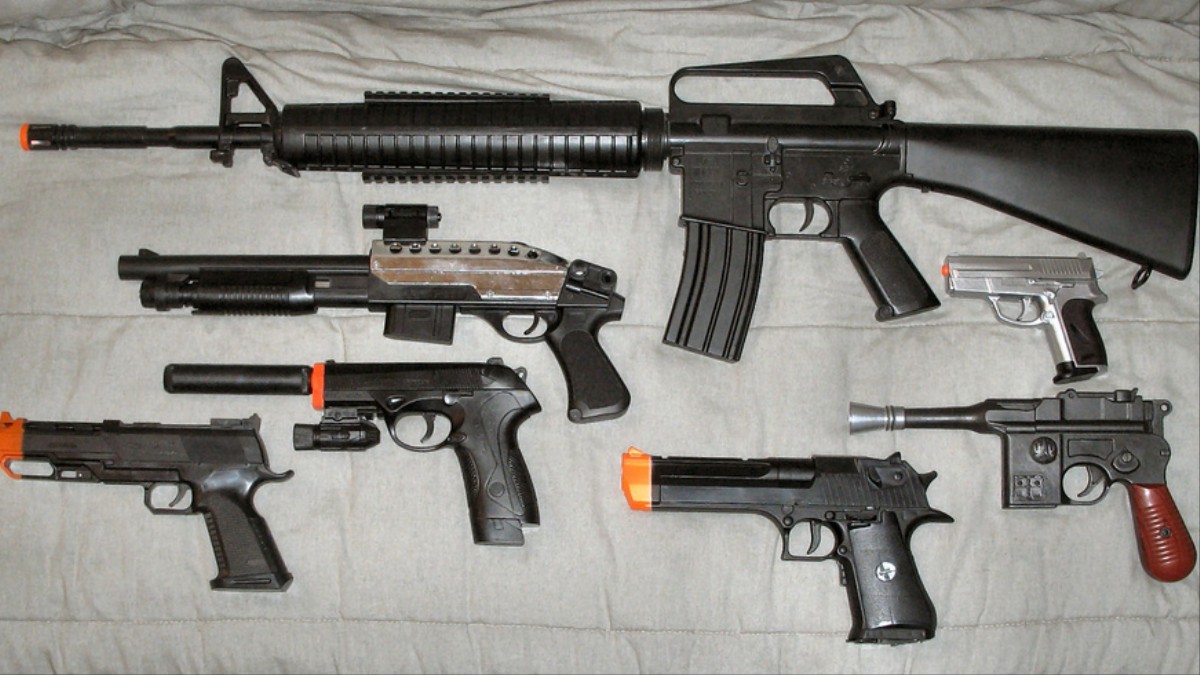
Fake guns have led to real police shootings. Photo Credit: Vice.
[5] Subject with Firearm or Appearance Thereof.
If a subject has a say a paint ball gun, a toy or replica gun; but may initially appear to look like a real gun, an officer may deem the gun as real and such risks a potential use of lethal force.
In these cases, an officer may only have one or a few seconds to make a ‘shoot or no shoot’ decision. The officer does not have the luxury to look at a weapon in the same manner (i.e. a still photograph) and close up, as the public or prosecutors do well AFTER an incident.
How even a fake appearing weapon is handled by someone in real-time, determines how an officer may respond to a perceived threat.
[6] Your Opponent Always Dictates Your Strategy.
Generally, if the subject has what appears to be a firearm, and is not facing the officer; (ie: subject has their back to officer(s); AND if the subject is not pointing the weapon or using it in any threatening manner to any other person); officer(s) may not necessarily use lethal force at that moment.
It is when the subject changes their behavior, is when an officer adjusts their tactics.
Scenario 1:
If a subject rotates their position, such that could result in pointing the firearm toward any other person or officer; that is more than likely going to be an episode of lethal force by an officer.
Scenario 2:
If a subject is reaching for an exposed firearm; that is more than likely going to be an episode of lethal force by an officer.
Scenario 3:
If an officer clearly commands, “let me see your hands,” “get down on the ground,” etc., and the subject ignores the lawful commands of an officer; and subject begins reaching for something unknown (concealed) from the officer; that is more than likely going to be an episode of lethal force by an officer.
(a) A Person’s Demeanor Factors Into an Officer’s Response.
What is the subject saying? Are they verbalizing threats to others? A subject may not say anything. Then it’s the non-verbal behavior of the subject that dictates the tactics used by the officers.
The officer does not have to wait to be fired upon in order to return fire. Depending on the skill of the shooter, one or more bullets can hit a person before the other person can pull their trigger finger.
(b) Fleeing Subject.
If a person is fleeing from an officer, either on foot or in a vehicle, there is a possibility that an officer will draw their gun. That does not mean fire the gun.
A feeling subject who is not doing any action that is an attack on an officer, or other citizen, lethal force should not be used.
If, on the other hand, the subject fired a projectile weapon (ie: a gun, Taser) at an officer, then lethal force may be deemed justified on the fleeing subject.
As previously discussed, a fleeing subject who demonstrates the behavior of reaching for what could be a weapon, there is a good chance lethal force may be exercised.
Again, an officer does not have to wait until they see a gun, a knife or other weapon to respond. A fleeing subject who takes actions to reach for anything on their body, in a vehicle, anywhere, could be interpreted as a subject seeking a weapon to cause harm to pursuing officer(s).
To avoid the risk of being Tased or shot by an officer, subject is best to stop, follow commands of the officer, and address the matter legally in court – not on the street.
(c) Armed Fleeing Subject – Hostage Risk.
Lethal force may also be used to prevent hostage situations. A fleeing subject with a weapon attempts to run into a business, store, or residence which puts all citizens in those structures in harm’s way. To prevent the risk of injury or death of innocent civilians, an officer may decide to exercise lethal force to protect those innocent lives.
Fleeing, evading arrest, and resisting arrest, increases the chance of injury to the officer and the subject.
[7] Speed Chase Ends Without Incident After Subjects Fairly Cooperated With Officer’s Commands.
In the following August 2020 video, we have feeling subjects in a vehicle in Florida. Subject vehicle had been spike-striped, and driver eventually loses control in a ditch.
Speed chases are always going to be ‘felony stops’ (police have guns drawn). Let’s watch and review. [This first video is non-graphic. No actual shooting.]
Notice the male gets wise and complies with the officer’s commands. Officers can see there is no weapon in his hands or in his waistband. He is not hurt, and arrested without further incident.
The female however took a huge risk by walking out with her cell phone in one hand. The phone could have been misinterpreted as a weapon. She then makes another mistake by lowering one hand and concealing her actions from the street officers. She was tucking a phone in the front of her waistband.
What she does not understand is that her phone will be confiscated whether it was left in the car or on her person. She’s not going to be able to take her phone and sit in a jail and Tweet, or watch TikTok videos. She will eventually get the phone back when she is out of jail. But her actions put herself in a riskier situation. Notice the street officer(s) yell at her louder, and repeat commands to put her hands up. She soon complied, and was arrested without further incident.
[8] Don’t Unilaterally Reach For Anything When Perused.
In the following 2018 incident in Texas, a man was running toward an officer and reaching in his waistband. Both actions will be deemed as aggressive and potentially threatening behavior by the perusing officer. As a result, the subject was shot.
[Video contains officer shooting subject.]
[9] Suspect on the Ground. Suspect Reaches for Gun.
There was a report of a subject with shots fired at an officer. Further report said there is multiple shooters. Next, officer(s) in police vehicle arrive on scene where one subject was previously shot, and now is seen on the ground. A hand gun is also seen near the subject on the ground.
Anytime a report of a subject with a firearm will always be a felony stop (guns drawn by PD).
Officer told subject to put hands up. Subject initially complied. Then subject got stupid and reached for the hand gun, and for a split second, even managed to point the gun at officer(s), drawing fire from the officer(s).
[Video contains police dash camera, graphic shooting of subject.]
[10] Officer Killed in California Traffic Stop by Gunman.
The two most dangerous situations for an officer to address are domestic violence calls and traffic stops.
A 2019 traffic stop in California resulted in the driver pulling a rifle out, and killing the officer. The subject was subsequently killed in a mutual shoot-out with additional responding officers.
[CBS News & police video contains audio gun fire, but media removed actual graphics of persons being shot.]
[11] Police Request Unmarked Vehicles in High-Risk Pursuit.
In Las Vegas, April 21, 2020, a police officer attempted to stop a vehicle for traveling at an “excessive speed.” A police DMV check found that the license plate was reported stolen and belonged to a different vehicle.
The subject speed away from officers. Subject vehicle reportedly was traveling up to 100-120 MPH on a highway, and driving up to 80 MPH on city streets while not being pursued by police. Subject ignored at-least one red traffic light. A police helicopter also followed the pursuit of subject vehicle.
In this first [graphic video here], one officer calls off marked police cars and requests unmarked police vehicles involved to handle with the air unit.
The use of unmarked police vehicles draws less attention to criminal subjects. Unmarked police vehicles are used in all 50 states, and are especially used in high risk police events.
In the video below, the subject suddenly stops and blocks a red vehicle from exiting a parking lot.
Subject then exits ‘their’ vehicle with what appears to be an illegal short-barreled shotgun in hand – a felony under [NRS § 202.275]. The subject then raises the gun at the innocent civilian’s red vehicle. Subject walks toward the driver of the red vehicle, with said gun pointed at the driver.
Exiting unmarked police vehicles were uniformed police officers who immediately identified themselves. Subject quickly swung the shotgun toward officers and officers immediately began firing at the subject. Subject did not appear to expect to meet undercover police vehicles.
[Video contains graphic video of subject being shot.]
Again, anytime a gun is involved by a subject, use of deadly force could occur. According to Assistant Sheriff Zimmerman in the video above, this was the first officer-involved fatal shooting in 2020.
It was learned after-the-fact, subject had a prior criminal history in Nevada and Utah: Including possession and receiving stolen vehicles, theft, concealed weapons violation, felony obstruction of a police officer, and a felony warrant out of Utah for parole violation. Subject also deemed a felon in possession of a firearm.
We have two more examples.
[12] Subject Killed After Reaching For Possible Weapon Under Bed Mattress.
Another dangerous event for officers is executing warrants. In 2019, officers had a warrant to arrest subject known as Raymond Lee.
Lee, 54, a white male (for those who need to know), had outstanding felony warrants in California. Police knocked several times on the hotel room of wanted subject and repeatedly identified themselves as police.
The door opens at one point and a (white) female walks out with hands up with no further incident.
Lee, however is seen exiting the hotel bathroom, then puts both hands on the corner of a bed mattress.
Officers yell at Lee to “show me your hands,” and repeatedly stated the similar. Lee ignored the lawful commands of the officers. Lee begins to pick up the lower-right mattress corner, and appears to reach for something. Lee pulls out an item in his hands. Officers’ fire at Lee believing the weapon was a gun.
As it turned out, the item was a B-B gun.
Officers don’t have to ask, hey is that a real gun? If one appears to reach for something, ignores officer commands (‘put hands, up, let me see your hands,’ etc.); that can put the idea in the officers’ mind that the subject may be reaching for a weapon.
The officers were cleared in the shooting.
[Video contains graphic video of subject being shot.]
In our last example, we see a wanted felon who at first seemed to comply with an officer, but this was just a ploy to surprise attack the officer.
[13] Wanted Felon Pulls Concealed Taser on Officer.
Subject: A male (white) felon allegedly wanted for bank robbery in Minnesota.
Subject walks back to officer’s car with officer behind him. Subject then reaches inside his jacket, reportedly pulls out a Taser; and then grabs the officer’s neck as to pull the officer into the attack.
The officer manages to break free, moves away from the subject while subject rushes toward the officer. Officer immediate fires at the attacking subject.
[Video contains video of subject being shot.]
There are numerous examples of use of force incidents we could discuss regarding officer-involved shootings. ALL of these shootings could have been avoided.
[14] Keys to Help Avoid Getting Into a Shooting Situation.
- The obvious starts with don’t commit crimes.
- Avoid using or dealing in narcotics. They can cloud (impair) one’s judgement.
- If drink, don’t drive.
(a) During a Vehicle Stop.
Roll down all windows as you are slowing to stop the vehicle. Make sure radio/ music, etc., is off. Don’t be on the phone or answer the phone during the stop. Put both hands on the steering wheel like ’10:00 AM’ and ‘2:00 PM’ on a clock. Or, put both hands (and arms) outside of vehicle so officers can see you are not reaching for a weapon. Follow officer’s instructions.
Always keep one hand on the steering wheel as above if possible. If have to reach for papers in a glove box, do this with one had on the steering wheel, and tell the officer where the papers are located before you reach for them.
If have a purse, open it slowly in your lap, so an officer can see you are not reaching for a weapon inside.
Always put both hands back on the steering wheel as said when just talking with the officer.
Don’t argue with the officer. If you think the officer is wrong, argue your point in court.
(b) Vehicle Stop with Weapon In Vehicle.
If have a weapon (knife, gun, etc.,) ANYWHERE on person or in vehicle, and get pulled over:
Consider following the same instructions as above “(a)”. Calmly advise officer that you are disclosing that there is a ______ in the vehicle, where it is located, and you are ready to following the officer’s instructions.
Do NOT ever reach for a weapon around an officer. One could get killed. Reaching for a weapon can be seen as a cause for lethal use of force.
Even if one is thinking they are just ‘handing over’ the weapon to the officer – don’t.
If the officer asks for the weapon, one may want to tell the officer that you don’t feel conformable reaching to get the weapon, and you rather be temporally in handcuffs while the officer safely retrieves the weapon. The idea is NOT to put oneself in an unnecessary risk situation. By carrying a firearm, even legally, one accepts being at the top level where use of force could be used if this situation is not handled safely by the citizen.
If there are more than one type of weapons or multiple weapons on person or in vehicle, disclose all of this upfront and calmly to the officer. Failing to disclose weapons in vehicle upon a vehicle stop in some states is a crime. Check with your state or check with a lawyer in your state.
Follow the officer’s instructions exactly. Any debate, argument, resistance, or actions, such as moving one’s hands back in the vehicle could be seen as one reaching for a weapon.
(c) Vehicle Stop with Lawful Concealed Weapons Permit.
Consider the same guidelines as “(a)” and “(b)” above. If able without performing a bunch of obvious movements in vehicle, have driver’s license with current valid permit ready with both hands on the steering wheel like ’10:00 AM’ and ‘2:00 PM’ on a clock. Following officer’s instructions.
An approaching officer doesn’t know who you are, or who else may be in the vehicle. Anyone moving around, especially arm or hand motions in vehicle after the stop, may be seen as one hiding, or reaching for something. One wants to have the officer not to be put in an escalated defense mode because of citizen actions that could be misinterpreted.
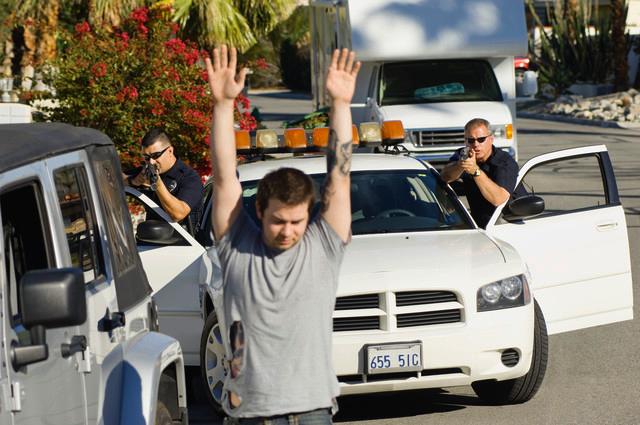
(d) Felony Stop.
A felony stop can occur for any of the following reasons, including but not limited to:
- Subject is wanted for a crime and is traveling in a vehicle.
- Subject failed to stop after police activate their (red/blue) light bar and siren, and such resulted even in a short pursuit; or otherwise, driver delayed stopping when officer attempted to pull vehicle over.
- Subject is known to have weapon(s).
- Subject is known to have committed violent crime(s) in the past.
- Subject recently or in the past made threats to anyone, including self-harm.
- Subject has harmed anyone.
- Subject is driving a reported stolen car.
- License plates don’t match registered vehicle information.
- Subject is being chased in a ‘high-speed’ police pursuit for any reason.
Now we’ve come to our final and most important part. This part addresses ideas when outside of a vehicle, or just on the street, have weapon(s), or may be a suspect in a felony stop (guns drawn at subject).
[15] How to Avoid Getting Shot by Law Enforcement.
- If have any weapon in hand, in one’s custody, reach or control; follow the exact commands of the officer.
- Do not hold or use the weapon in a manner that could be deemed ‘threatening.’
- Be cooperative. Unless otherwise instructed, tell the officer you are going to put the weapon down now: “I am putting it (the weapon) down.” As one is putting the weapon down, clearly and calmly verbally advise your action again (so everyone around can hear you). Repeat the words exactly several times while one is actually placing the weapon on the ground. In tense, noisy situations, an officer(s) may not have heard you the first time. So one wants to be calm, clear, and repeat, I am putting it (the weapon) down.” Don’t kick the gun, it could accidentally go off, and one could get shot. Take a few steps away from the weapon, so it can appear you cannot easily reach the weapon again. Don’t run or look like one is ready to flee.
- Next, put hands up in the air with fingers fully spread apart. This will show officer(s) that there is no weapon in hand.
- If there are still weapons on one’s body. Best advise the officer, weapon location, and follow officer’s commands.
- If no more weapons are on person, in their custody or control, continue to follow commands.
- Don’t resist arrest, don’t run away, and don’t physically fight with the officer(s). The officer(s) will see this as threatening behavior. This places BOTH the subject and the officer(s) in danger; thus risk of harm to all parties involved.
- Even if one thinks they are in the “legal right,” and the officer is “wrong;” follow the commands of the officer for now. Don’t get pissy. One’s attitude, tone of voice can impact the officer’s actions. If later, after an investigation, it was deemed the officer acted negligently, that will be against the officer.
- If there are weapons still in a vehicle, advise the officer of the location and type. If the weapons is a gun, advise it may be loaded. If an officer is harmed by a weapon in one’s custody or control, that person is responsible for the officer.
- The more one demonstrates cooperation and puts the officer(s) at ease, normally results in no harm to any parties involved. Yes, sometimes things go wrong, and the wrong party risks criminal charges and civil litigation for any wrongdoing. Be responsible for one’s own actions. Officers are responsible for their actions.
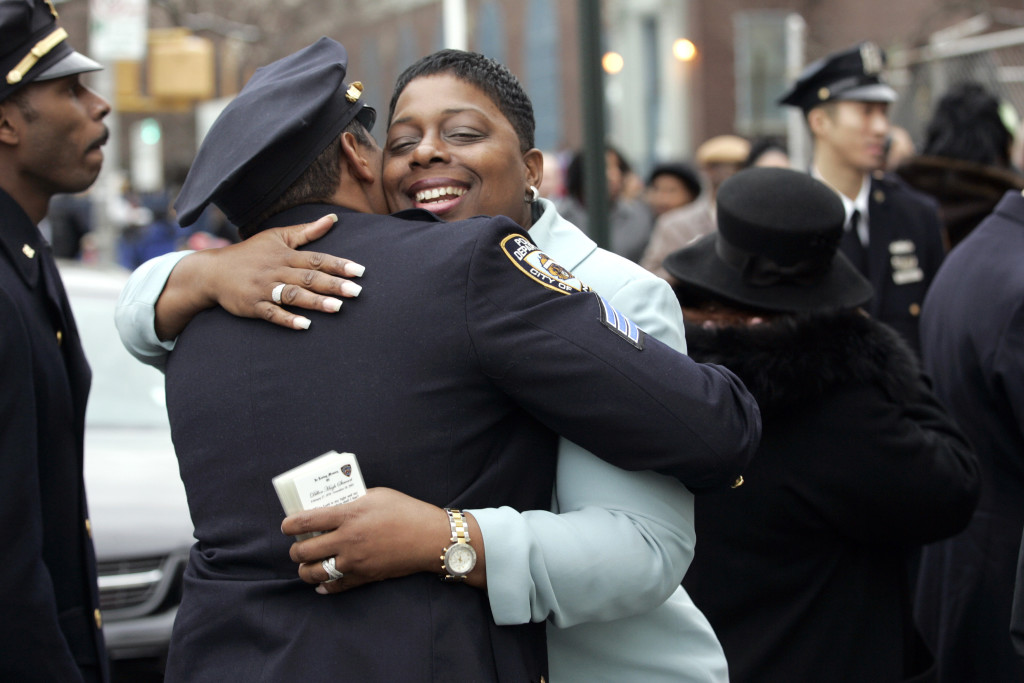
[16] Re-cap.
Remember, to avoid being a subject in a use of force incident, always comply with the officer’s commands even if you think they are wrong, and you’re innocent. The issues will get sorted out legally.
If one’s rights were violated by an officer, a citizen can file a complaint, and even take civil court action. Civil court action does not mean vandalizing or burning down the courthouse; or terrorizing the officer or their family. If the officer’s actions were deemed criminal, the officer could go to prison.
Keep in mind many officers have families too. An officer’s number one goal each day is always the same: Come home safely.
The more difficult one makes it for an officer to perform their lawful duties; or the more anger or violent a subject becomes; or anytime a subject may appear to reach for, or actually has a weapon; the officer goes into fight or flight mode too. It is the officer’s duty to stop the current (criminal) behavior with sufficient force given a situation.
Yes, again, there are incidents when police officers have used both excessive and justified use of force, and we will discuss a number of high-profile events in our next report.
Net Advisor™ has received a number of certifications including laws of arrest, search warrants, and laws regarding the use of force. Laws can change, and vary between states and municipalities. Opinions here, and on this website, are not to be construed as legal advice. Disclaimer.
If you liked this article, please “like us” on Facebook or share on Twitter or through your favorite social network.
Images, graphics, videos may be copyright by their respective owners. Please advise for uncredited items.
Original content copyright © 2020 NetAdvisor.org® All Rights Reserved.
NetAdvisor.org® is a non-profit organization providing public education and analysis primarily on the U.S. financial markets, personal finance and analysis with a transparent look into U.S. public policy. We also perform and report on financial investigations to help protect the public interest. Read More.
